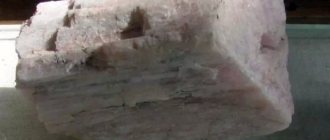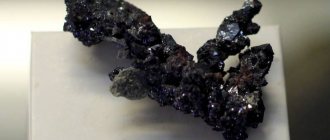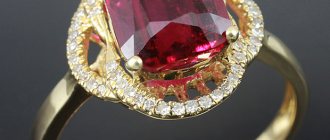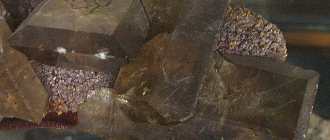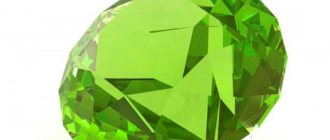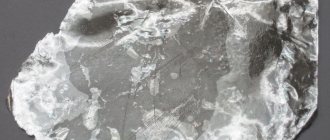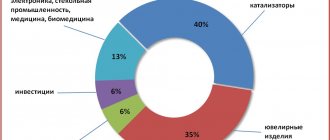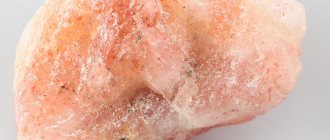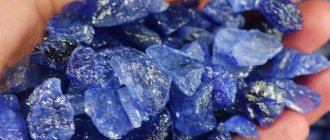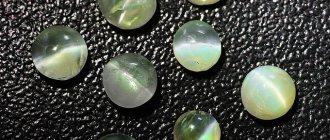| Category | Oxides (minerals) |
| Title in English | Magnetite |
| Formula | FeFe2O4 |
| Group | Spinel group |
| Color | Black |
| Stroke color | Black |
| Shine | Metal |
| Transparency | Opaque |
| singonia | Cubic |
| Hardness | 5,5 — 6 |
| Cleavage | Imperfect |
| Density, g/cm³ | 4,9 — 5,2 |
| Kink | Conchoidal |
| origin of name | Unfortunately, the history of the origin of the name magnetite stone has not been preserved to this day. According to unconfirmed information, the mineral was named after a person documented by the ancient Roman philosopher Pliny the Elder. It was the shepherd Magnes who accidentally discovered natural magnetism by discovering the mineral we are now talking about. |
This mineral was first discovered by the Greek shepherd Magnus, and after his name it was called magnetite. According to another version, the name of the stone comes from the name of the ancient city of Magnesia, in Asia Minor. At the same time, in almost every country magnetite received its own name. So, in China it is known as “chu-shi”, in Greece as “adamas” and “kalamita” or “stone of Hercules”, in France it was called “ayman”, the inhabitants of India - “thumbaka”, in Egypt - “eagle bone” ”, in Spain - “piedramant”, in Germany - “magness” and “siegelstein”, in England - “loudstone”.
Magnetite deposits
Magnetite formation usually occurs in rocks of igneous or metamorphic origin.
Sometimes it is also found in the form of magnetite sand, in placers. Natural magnetite aggregates form as a dense, granular or draining mass. Interestingly, magnetite grains can often be found in a handful of sand or a sample of any other rock. — Advertising —
Among the industrial stone deposits, the most famous and significant today are those located in the Urals, Kazakhstan and Azerbaijan. The mineral, which is mined in the Irkutsk region, is famous for its bright shine and beautiful shapes. Magnetite deposits are also found in countries such as the USA, South Africa, Sweden, and Canada.
Amulets, amulets and talismans
Red hematites are considered the most powerful amulets. Their main meaning is to protect people. It also develops subtle feelings, originality of thinking and intuition. Maintains the health of the owner on the physical and astral plane.
Hematite bracelet
The hematite bracelet brought new popularity to the mineral. Production started in the 70s. Since then, on the wrists of such celebrities as Kate Moss and Sarah Jessica Parker, you can often see bracelets with beads cast in metal. Despite its expensive appearance, natural hematite is inexpensive.
Decoration stabilizes blood pressure, increases hemoglobin, has a beneficial effect on blood composition, and relieves headaches.
Important! It is not recommended to wear jewelry near the watch; the magnetic field negatively affects the operation of the mechanism.
Compatibility with other stones
Hematite harmonizes with diamonds, amethysts, turquoise and emeralds, both on the energetic level and externally. Less commonly, it is used in compositions with rock crystal, garnet, opal, moonstone and rubies. The main thing is that its compatibility coincides with the elemental stones.
Important! The amulet works best if it is encased in silver. Bloodstone is not made for a gold setting.
For men
The magical properties of hematites are especially necessary for men. It helps to develop willpower, courage, and charm. The ring with the mineral is worn on the right index finger. Decorating a man increases his positive energy, protects him from negative influences from ill-wishers, and helps him win in competition.
For women
Blood stone adjusts the menstrual cycle. It has a beneficial effect on the condition of the skin, making it velvety. Helps with metabolic disorders, which promotes weight loss. Girls are encouraged to wear beads so that everyone around them can see them. This way, envious people will not be able to jinx/slander its owner. Put the jewelry on in the morning and take it off before going to bed.
How to wear and care
The stone is not worn on a daily basis. It is worn on special occasions:
- Hypertensive patients are advised to wear jewelry on the waning moon, and hypotensive patients on the waxing moon.
- If you have problems with blood vessels, it is recommended to wear earrings with hematite.
- For VSD, it is recommended to wear a bracelet complete with a ring.
- The pendant or necklace stimulates blood flow.
Important! Hematite jewelry is very fragile, they are protected from falls. They are removed before playing sports or cleaning. Store in bags made of thick fabric.
The hematite mineral thoroughly absorbs negative energy from the environment. Therefore, after prolonged use, the energy of the stone is thoroughly cleaned. Preferably every 1-2 months. The decoration is kept for 3-5 minutes under running water, or left in coarse table salt.
Who is the mineral not recommended for?
Hematite is a capricious stone. He may dislike his owner for no apparent reason. Before wearing jewelry with it, it is recommended to hold it in your palm. If the sensations are pleasant, then you can safely take him as an assistant. It happens that you intuitively want to remove the mineral away, then it is better to abandon it. You should also pay attention to the influence of the zodiac circle. Pisces, Virgo and Gemini rarely benefit from wearing the mineral.
What is the price?
The price will please collectors:
- Jewelry with a silver frame costs from 2,000 rubles.
- Rare varieties, for example, iron rose, cost from 8,000 rubles.
- A ring made entirely of bloodstone hematite costs 500-600 rubles.
- Pendants with a silver tint cost 400-600 rubles.
Do you believe in the unique properties of hematite, have you felt its energy? Tell us what impact it had on you?
History of magnetite
The magnetite stone, endowed with unusual properties, has been known to man for a long time.
Thus, the inhabitants of China mentioned its use back in the 6th century AD. Then magnetite was used as a compass and with its help they went to explore unknown lands. Plato described the properties of magnetite in his works. The philosopher noted the stone’s ability to attract various objects, as well as transfer its energy to them, as a result of which they also began to attract iron products, that is, the magnetization effect.
According to ancient legends, the name of the stone was given by the name of the shepherd Magnus. His shoes had iron nails, and the tip of his staff was also made of iron, which caused them to be attracted to stones. There is another version, according to which the mineral is named after the city of Magnesia, now located in Turkey. Not far from it there is a mountain that was often struck by lightning. There is a similar mountain in the Urals. It is called magnetic, and its composition is almost entirely magnetite. Mount Zimirt in Ethiopia is also made of magnetite and, according to legend, is capable of pulling nails out of ships and attracting all iron products to itself.
— Advertising —
In general, the name of the stone has changed many times. For a long time it was known as simply “magnet”, later as “magnetic iron ore”, and only at the end of the 19th century it acquired a new name - magnetite.
Where is it used?
Magnetic iron ore has found application in industry, medicine and beauty:
- For metallurgists, this is a valuable raw material for the smelting of certain types of steel. For the chemical industry it serves as a source for the production of phosphorus and vanadium.
- “Magnetic” probes are used to remove metal objects that have entered the respiratory system or esophagus. This is especially valuable in the case of young children.
- The specificity of the color limits its use by jewelers. But it is ideal for men's assortment or business style. Magnetite is often combined with hematite and pyrite in jewelry.
Magnetite jewelry
The magnetite mineral is loved by hand-made craftsmen.
They position their products as protective or medicinal.
Physico-chemical characteristics of magnetite
By chemical nature, magnetite is a complex compound of iron (II) and (III) oxides.
It is painted black with a pronounced metallic sheen; a matte surface is rare. The mineral is opaque; transparent specimens are rare. Hardness on the Mohs scale 5.5-6. The specific gravity is 4.9-5.2 g/cm3. At the fracture, the crystals are conchoidal or unevenly stepped. The ferromagnetic properties of magnetite are very pronounced. The stone can even cause changes in the compass. When the mineral is crushed to a powder state, its magnetic properties are preserved. Magnetic sand is also attracted to magnetic poles.
Ore magnetite is mainly granular aggregates. Individual crystals are found in octahedral, rhombic dodecahedral forms, and combinations thereof. Unique natural magnetite balls are also valued.
Who is it suitable for?
In astrology, magnetic ore is associated with such zodiac signs as Capricorn and Aquarius. Iron ore gives these people confidence in their abilities and the opportunity to realize their potential. But it will not suit melancholic Pisces and sensitive Cancers, since its energy is too aggressive for representatives of these signs.
Magnetic ore is a talisman of strong-willed and decisive individuals who know exactly what they want from life. Iron ore literally attracts the energy of success and prosperity, and this will help a person achieve his goals.
Prices for iron ore vary, but they do not exceed 150–700 rubles. A small ironstone cabochon, the length of which does not exceed 5 mm, costs about 150 rubles. The price of a rosary, beads or bracelet made of stone is at least 700 rubles.
It is recommended to purchase products made from magnetic ore in specialized stores, where the buyer will certainly not be offered the purchase of a fake mineral of a luxurious black color.
Magic properties of magnetite
Magnetite has been known for its magical powers since ancient times.
Because of its magnetic properties, it has always been popular among alchemists, magicians and sorcerers. The gem is endowed with powerful protective properties and protects its owner from all enemies. The stone is a stimulator for inventors in creating new products, helps to draw up plans and create new projects. Magnetite also reveals and enhances psychic abilities. For these purposes, it is placed on the third eye area and meditated.
Unconventional practices
The stone is popular in unconventional spiritual practices and esotericism. Serves as raw material for amulets, things for ritual procedures and meetings.
The stone is considered to be the patron of creative individuals.
According to legend, it provides a barrier from the evil eye, from sorcerers and evil spells. It is recommended to wear appropriate accessories in crowded gatherings. Developments
The mineral comes from igneous rocks: granite, diorite, etc. Deposits of large volumes are found in iron ores that attract it. The stone may appear as a homogeneous mass or appear in ore in places. Grains are rarely found in marine silt sediments, appearing there as a result of decomposing organic remains.
The mineral is mined in the Russian Federation (Kusinskoye, Kopanskoye, deposits on the Kola Peninsula, KMA, Karelia), in the Ukrainian Krivoy Rog, and in the Kazakhstani Kustanai. From far abroad, deposits of Canada, Norway and the USA can be noted.
Healing properties of magnetite
Modern lithotherapy recommends the use of magnetite for diseases of the nervous system.
In addition, it has an anti-inflammatory and analgesic effect, accelerates the healing of tissues and bones in case of ulcers, wounds, fractures, and burns. Magnetite is also used to treat disorders of the cardiovascular system, allergic dermatoses, and gynecological diseases.
For the purpose of healing and stimulating the body, special magnetic bracelets and magnetite balls are recommended.
Magnetite powder is used as a hematopoietic agent for anemia, severe blood loss and general weakness.
Healing qualities
In modern medicine, stones are often used, but there is no scientific evidence of exactly how the magnetic field affects a specific disease. One of the most popular ideas was put forward by G. Shipov, who explained the influence of a magnet on the processes occurring in the human body using a strong torsion field.
Among the scientifically proven beneficial properties are:
- rejuvenating effect on the body;
- slowing down the development of bacteria;
- wound healing;
- assistance in the treatment of eye diseases, Parkinson's disease.
Magnetophoresis is prescribed for varicose veins, radiculitis and bone fractures (reduces the time for their healing) and bronchitis. Magnetite iron balls are used for therapeutic massage of various diseases.
Applications of magnetite
Since the 17th century, magnetite has been widely used in medical practice.
Along with medicinal qualities, the stone also has valuable jewelry properties. It is cut into cabochons or made into balls, rosaries and beads. The main rule is that jewelry with magnetite cannot be worn without taking it off, so as not to harm the body. Magnetite also underlies the invention of the compass, without which it is difficult to imagine the development of mankind.
Types of stone
In mineralogy, magnetic ore exists in several varieties:
- Titanomagnetite: the composition, in addition to iron oxide, includes titanium oxide. The stone contains impurities of coulsonite, due to which the mineral is used in the synthesis of vanadium.
- Kulsonite: The stone consists of 5% vanadium.
- Chromium magnetite: gets its name from its chromium content.
- Maghemite: A ferromagnetic oxide of iron that is not often found in nature.
Magnetic ore in mineralogy is considered the stone that contains the largest amount of iron.
Prices for magnetite products
A magnetite with a diameter of about 2 mm, cut into a cabochon, is estimated at about 2-3 dollars.
Magnetite rosaries can be purchased for $10-15. The cost of other products depends on their setting and the complexity of the jeweler’s work. Special massage balls made of magnetite, which are used to combat cellulite, are on average priced at $20 per set.
Interesting facts about magnetite
- Since ancient times, magnetite was considered a powerful magical stone, and all because people were afraid and did not understand its magnetic properties. Thus, gates made of magnetite did not allow armed enemies into the city. Amulets made of magnetites were considered the best protectors from all misfortunes.
- In China, there is a legend about how magnetite brought victory in battle to Emperor Huang Ti. The ruler launched a cunning attack on the enemies from the rear. But there was thick fog and in order to reach the desired position, the emperor used magnetite figures in the form of men with an outstretched arm. This was the prototype of the modern compass.
- The healing properties of magnetite were discovered at the end of the 18th century, after the doctor Friedrich Mesmer used it to treat a patient who had convulsions, paralysis and constant severe headaches. The doctor used all the remedies known at that time, but nothing helped. Then he tried to apply strong magnets to the patient’s body and relief came literally immediately. After a course of procedures, the woman fully recovered. And doctors began to widely use magnetite in their practice. Today, mineral-based massage balls are especially popular.
Compatibility with Zodiac signs
Astrologers do not particularly revere magnetites. These stones are suitable for all zodiac signs. But they can bring great benefits:
- Aries;
- Scorpio;
- Capricorn.
The mineral will bring good luck to these zodiac signs, allow them to gain self-confidence, and bring a difficult situation under control. The stone must be worn for several days if an important decision has to be made, for example, regarding moving, changing jobs, or social status.
The remaining signs of the Zodiac can use the magical properties of magnetite in the process of meditation, but this will require the ability to concentrate all thoughts on one important subject or goal.
